16.2 Evolution Policy
The Evolution policy is used to configure the Evolution e-mail client.
To configure the Evolution policy:
-
In the ZENworks Control Center, click the tab.
-
In the list, click , then click to display the Create New Policy page.
-
In the list, click , then click to display the Policy Name page.
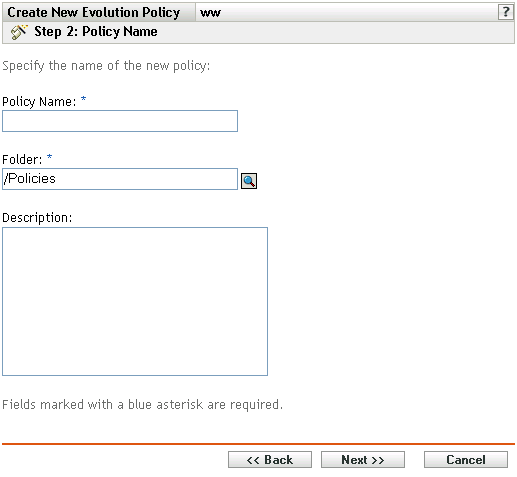
-
Fill in the fields:
-
Policy name: (Required) Provide a unique name for the policy. The name you provide displays in the ZENworks Control Center interface, which is the administrative tool for ZENworks Linux Management.
For more information, see Section C.0, Naming Conventions in the ZENworks Control Center.
-
Folder: (Required) Type the name or browse to the folder that this policy will be created in. Folders display in the ZENworks Control Center.
-
Description: Provide a short description of the policy. This description displays on the policy's Summary page in the ZENworks Control Center interface.
-
-
Click to display the Evolution Lockdown Settings page.
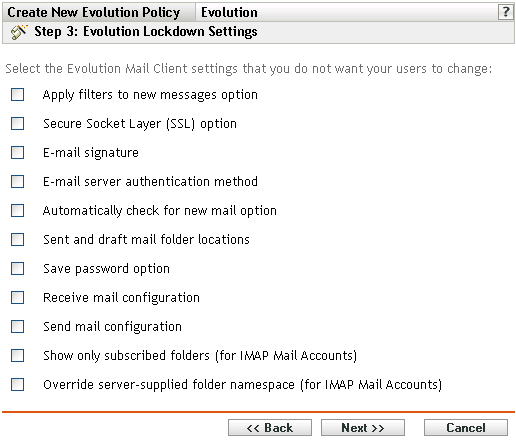
-
Select the desired options (by default, all options are disabled):
The options on this page allow you to prevent users from changing the following Evolution e-mail client settings. Select an option to prevent users from changing that setting in the Evolution e-mail client.
Apply filter to new messages option: Applies the filter to all new messages users receive.
Secure Socket Layer (SSL) option: Specifies whether the Evolution e-mail client should connect to the server using SSL.
SSL is a protocol that provides encrypted communications on the network and enables secure communications between the Evolution client and the server.
E-Mail signature: Specifies whether an e-mail signature should be added to the contents of a message.
E-mail server authentication method: Specifies the kind of authentication to be used when users connect to the mail server.
Automatically check for new mail option: Specifies whether the Evolution client should automatically check for new mail.
Sent and draft mail folder locations: Specifies the folders that users can select to store draft and sent mail.
Save password option: Specifies whether passwords should be saved so that users are not prompted for a password at every login.
Receive mail configuration: Configures the various options for receiving mail. For example, e-mail server and authentication details, checking for new mail, and applying filters.
Send mail configuration: Configures the various options for sending mail, for example, server and authentication details.
Show only subscribed folders (for IMAP mail accounts): Specifies that only the subscribed IMAP folders be shown to users. Internet Message Access Protocol (IMAP) lets users access e-mail messages that are stored on the mail server. Because the mail folders exist on the IMAP server and accessing them is time-consuming, Evolution lets users subscribe to certain IMAP folders.
Override server-supplied folder namespace (for IMAP mail accounts): Lets users change the IMAP name space that contains mail messages for the server.
NOTE:Users cannot create a new Evolution e-mail account if Receive Mail Configuration and Send Mail Configuration settings are included in the policy. These settings should be included in the policy only if the users' e-mail accounts have been created in the Evolution e-mail client.
-
Click to display the Evolution Configuration Settings page.
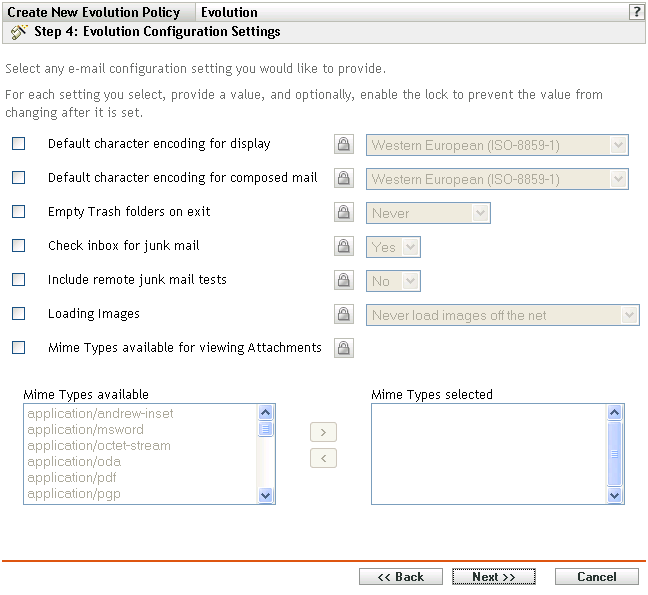
-
Select the desired options (by default, all options are disabled).
For each option you enable, provide a value. When you enable an option, it is locked by default. You can unlock the option by clicking
 . The options that are not enabled are excluded from the policy and are not applied to the device.
. The options that are not enabled are excluded from the policy and are not applied to the device.
Default character encoding for display: Lets you choose a character interpretation set for displaying e-mail messages. The default character interpretation set is Western European (ISO-8859-1).
Default character encoding for composed mail: Lets you choose a character interpretation set for composing e-mail messages. The default character interpretation set is Western European (ISO-8859-1).
Empty trash folders on exit: Lets you specify when to empty the Trash folder. The available options are , , , , and .
Check inbox for junk mail: Lets you specify if the incoming mail must be checked for junk mail.
Include remote junk mail tests: Lets you specify if the remote junk filtering option should be used for filtering incoming mail.
For example, the Evolution client stores a message in the Junk Mail folder if it finds the mail address a blacklisted address.
Loading Images: Lets you decide how images embedded in e-mail messages are loaded in the Evolution client.
The following options are available:
-
Never load images off the Internet: If you select this option, the Evolution e-mail client never loads images. If you select this option users can still view the images in the message by selecting the appropriate menu options in the Evolution e-mail client.
-
Load images if sender is in address book: If you select this option, images are loaded only if the sender of the e-mail message is in the receiver's address book.
-
Always load images off the Internet: If you select this option, images are loaded regardless of their source.
Mime types available for viewing attachments: Lets you select the MIME types that Evolution allows to be viewed using available Bonobo controls.
Evolution provides built-in support for opening certain MIME types. Those MIME types that are not supported by Evolution can be viewed by using certain available Bonobo controls. Bonobo controls provide a means to view both the MIME types that are supported and those that are not supported by Evolution.
After you select this option, you can select items from the list and then use the arrow button to move the selected item to the list.
-
-
Click to display the Default System Requirements for Evolution Policy page.
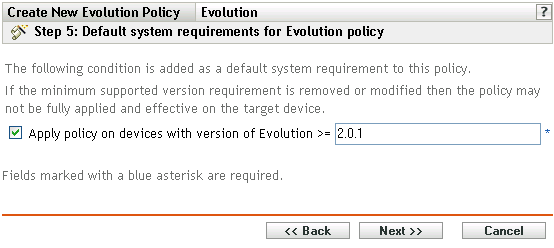
-
Specify the minimum system requirements that must be satisfied for the Evolution policy settings to be effective.
The field displays the minimum version of the Evolution client required for all policy settings to be effective. Evolution 2.0.1 is the minimum required version. Policy settings are applied only if the user has the same or a later version of the Evolution e-mail client installed. If the user does not have the Evolution e-mail client installed or has an earlier version than the specified version, the policy does not apply.
Even if you do not include this system requirement in the policy, the system checks whether the Evolution client is installed on a managed device or not. If the system finds the Evolution client on a device, it also checks the version. If it finds an earlier version than the specified one, the policy is enforced but a warning message is generated. If the Evolution client is not installed on a managed device, the policy is not enforced and an error message is generated.
-
Click to display the Summary page.
-
Click to create the policy as configured according to the settings on the Summary page. If you click , the Evolution policy is created but it does not have devices assigned or a schedule specified. At some point in the future, you need to configure additional options for the policy by continuing with Section 17.4, Assigning Policies.
or
Click to display the Policy Assignment page to perform the following tasks:
-
Specify assignments for this policy
-
Specify the schedule for this policy
-
Specify groups for this policy
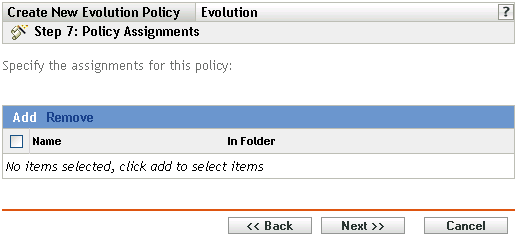
-
-
Assign the policy to the devices.
-
Click to browse for and select the appropriate Server or Workstation objects.
You can also select Folder or Group objects.
-
Click the down-arrow next to or to expand the list, then click the underlined link in the column to select the desired objects and display their names in the list box.
Assigning a policy to a Group object is the preferred method of assigning the policy. Assigning the policy to a large number of objects (for example, more than 250) might cause increased server utilization.
-
Click .
-
-
Click to display the Policy Schedule page.
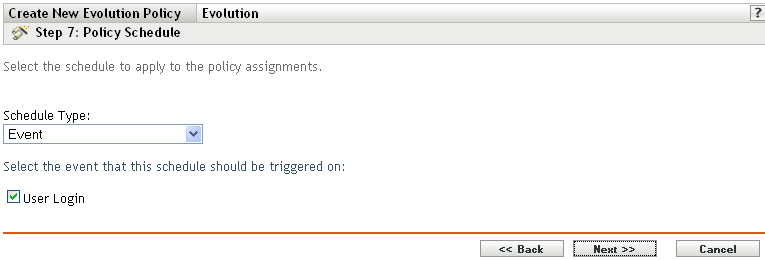
-
Select the schedule to apply to the assignments from the drop-down list, then select the desired options, which vary, depending on the schedule type you select.
The settings you configure on this page determine when the policy is applied to devices.
See Section 15.3, Schedules for information about the available schedules and their options.
-
Click to display the Policy Groups page.
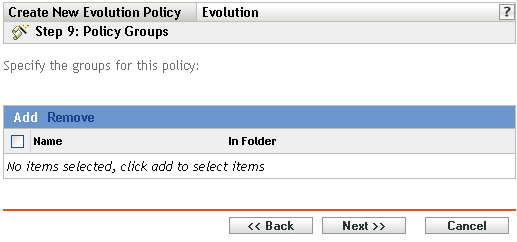
-
(Optional) Click to open the Select Groups dialog box, then click the underlined links in the column to select the desired policy groups and display their names in the Selected list box.
Using policy groups eases administration efforts by letting you group several policies so you can use common assignments, schedules, and so forth, rather than configuring these settings for each policy you create. For more information, see Section 17.3, Creating Policy Groups.
-
Click to display the Finish page.
-
Review the information on the Finish page, making any changes to the policy settings by using the button as necessary. Click to create the policy as configured according to the settings on the Finish page.